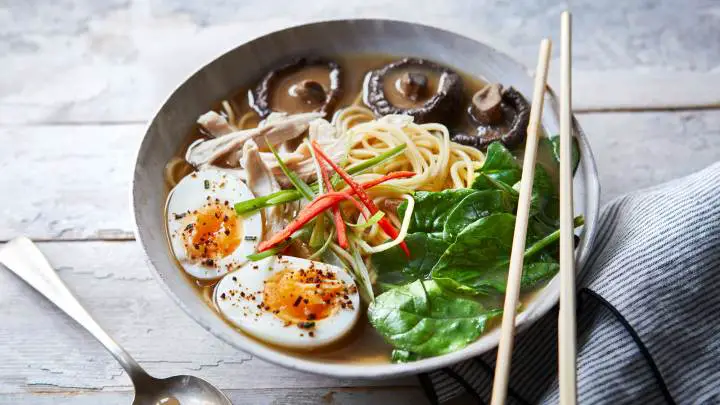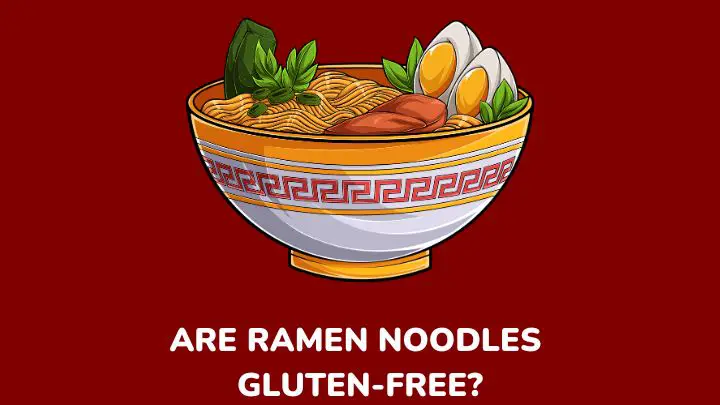Ramen noodles have become very popular and you can call them a lifesaver on a lazy day because they are convenient and easy to prepare. However, eating ramen noodles in Asian restaurants can be a little challenging for people eating gluten-free.
A gluten-free diet could be recommended for several reasons. It could be as a lifestyle or due to gluten sensitivity or celiac disease. For whichever reason you are eating gluten-free, you should read this article.
You will get to know why some varieties of ramen noodles cause you digestive problems and some do not. There is also a list of gluten-free alternatives that will help you create a healthy gluten-free meal plan.
What are ramen noodles?

Ramen noodles are Japanese wheat-based noodles. They are used in the preparation of ramen, a noodle-based dish that is a combination of meat broth made with soy sauce or miso, pork, eggs, mushrooms, seaweed, fish cakes, and green onions.
The raw ramen noodles are made from wheat flour, salt, and water. There are traditional ramen noodles and instant ramen noodle packets.
The instant packs contain a flash-dried or air-dried block of noodles, a sachet of seasoning, and dehydrated toppings. As the name instant implies, they are easy and convenient to prepare, unlike the traditional variety.
Are ramen noodles gluten-free?
Traditional ramen noodles are not gluten-free. They are made with wheat flour and are usually prepared with soy sauce which is not gluten-free.
For people with gluten sensitivity, eating ramen noodles can be likened to eating wheat bread and cakes. It could trigger the symptoms associated with gluten sensitivity.
However, there are plenty of gluten-free options such people can eat. These varieties use gluten-free flour like potato, rice, and millet flour.
Also, how you cook the noodles matters a lot. To enjoy 100% gluten-free ramen noodles, cook it without gluten ingredients like soy sauce.
Are ramen noodles healthy?
Ramen noodles are carbohydrate-rich noodles, which makes them a good source of energy. They also contain fats, protein, iron, and some B vitamins.
According to Healthline, one serving of chicken-flavored instant ramen noodles contains:
- Calories: 188
- Carbs: 27 grams
- Total fat: 7 grams
- Protein: 5 grams
- Fiber: 1 gram
- Sodium: 891 mg
- Thiamine: 16% of the Reference Daily Intake (RDI)
- Folate: 13% of the RDI
- Manganese: 10% of the RDI
- Iron: 9% of the RDI
- Niacin: 9% of the RDI
- Riboflavin: 6% of the RDI
It is high in calories but low in vital nutrients, such as protein, fiber, calcium, magnesium, potassium, and vitamins A, B12 & C.
How can you make your ramen noodles more nutritious?
Prepare your broth
Making your broth and seasoning for ramen noodles can be stressful but it is worth it. Preparing your broth allows you to make modifications that suit your dietary needs. It will also help to reduce the sodium content.
Cut down on sodium
You can reduce the sodium content in your ramen noodles by using half or less of the flavor packet if you are cooking instant noodles. You can also strain the noodles to reduce the broth.
Add some veggies
Ramen noodles are low in essential vitamins and minerals. You can make up for this by adding more veggies to your noodles. Mushrooms, carrots, pak choy, broccoli, and cabbage are excellent options to incorporate into your meal.
Add more proteins
Poached eggs, fried eggs, tofu, or edamame are some rich protein options you can add to your ramen noodles to make them more nutritious. They also help to make it heartier and more filling.
Gluten-free alternatives to ramen noodles
Gluten-free ramen noodle brands
Manufacturers of gluten-free ramen noodles use starches and rice flour instead of wheat flour. They are harder and rarely contain ingredients like MSG. Some popular brands are:
- Lotus Foods Ramen Noodles, which are available in microwavable cups and stovetop packages
- Gluten-Free Meister Japanese Ramen
- ONETANG Organic Buckwheat & Brown Rice Ramen Noodles
- Thai Kitchen Gluten-Free Rice Noodles
- Gefen Gluten-Free Brown Rice Ramen Noodles
- Shaman Ramen which is also soy-free
- Big Green Organic Millet Ramen
- Thrive Market Keto Noodles
- Annie Chun’s Rice Noodles
- Explore Cuisine Organic Rice Noodles
- Jovial Organic Gluten-Free Brown Rice Spaghetti/Capellini/Fettuccine
- King Soba Organic Ramen
Rice noodles
Rice is a gluten-free grain and are the noodles made with it. These noodles come in different shapes – vermicelli, pad thai, rice sticks, or chow fun are some shapes that perfectly mimic ramen noodles. They are perfect for stir-fries and ramen soup.
Buckwheat soba
The soba which is an alternative to ramen noodles is the buckwheat variety. Buckwheat is a gluten-free grain and is suitable for people with gluten sensitivity or celiac disease. You can make these noodles into any ramen recipe.
Glass noodles
Glass or cellophane noodles are made from the starch of mung beans, potatoes, sweet potatoes, or tapioca starch. These noodles are mostly used to make stir-fries, but you can also use them in ramen soup.
Kelp noodles
Kelp noodles are made with kelp, but you can enjoy them ramen-style – stir-fry or soup. They are also high in iodine, which is good for thyroid health. Not everyone likes these noodles, but if you can eat them, good for you.
Shirataki
Shirataki noodles are made from konjac, a yam-like crop that is equally starchy. They do not have any flavor of their own, so you must always eat them in broth.
Vegetable noodles
Zucchini noodles are the most common type of vegetable noodles. Other types of vegetable noodles are beets, butternut squash, daikon radish, summer squash, sweet potatoes, and carrots noodles. Use a mandoline, box grater, or spiralizer to shred your noodles at home.
You can serve these noodles ramen-style to enjoy more vitamins and minerals.
Are there side effects of eating ramen noodles?
There could be side effects to eating ramen noodles, especially when you consume too much of it. It is a high-calorie meal and high in sodium too.
Consuming too much ramen noodles increases the risk of metabolic syndrome in women. This is due to the high levels of saturated fat and sodium.
This could also increase the risk of developing hyperglycemia, diabetes, high blood pressure, heart disease, and stroke.
FAQs
Are Korean noodles gluten-free?
Not all Korean noodles are gluten-free. Most of them are made of gluten-free starches, water, and salt. However, some Korean noodle brands use wheat flour and other nongluten ingredients.
Are ramen noodles vegan?
Traditional ramen noodles are vegan, but not all store-bought varieties are vegan. The noodles are typically made of flour, water, and salt. But some manufacturers include eggs in your noodles.
Are gluten-free ramen better than traditional ramen noodles?
The traditional ramen noodles taste better and are more nutritious than the gluten-free store-bought varieties. However, traditional ramen noodles are not a healthy choice for people with gluten sensitivity.
Is ramen pasta?
Ramen is not pasta because it is made from wheat, not semolina like other types of pasta. Also, pasta is of Italian origin and is usually served with tomato or cream sauce.
On the other hand, ramen is of Japanese origin and is served with savory sauces, proteins, and vegetables in Asian cuisine.
Conclusion
Traditional ramen noodles are made with wheat and may also contain soy sauce, which makes them unfit for a gluten-free diet. But you do not have to give up on ramen noodles.
Several gluten-free varieties use other vegan gluten-free flour and nongluten ingredients.
These noodles are readily available in stores and are equally tasty. You can also make your noodles gluten-free by using only gluten-free ingredients.
Although some people say the traditional ramen noodles taste better than the gluten-free varieties, you are better off with them.
Looking for a way to get a bowl of ramen noodles ready in no time? Try to microwave style. If you don’t know how to, here’s how to cook ramen nodles in the microwave.
Thanks for reading.

